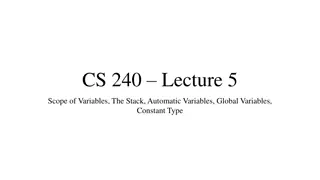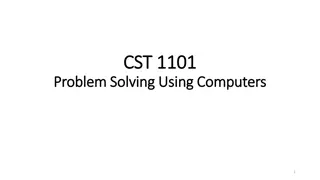Understanding Variables in Economics
Variables in economics, such as dependent, independent, endogenous, and exogenous variables, play a crucial role in analyzing economic phenomena. Dependent variables are influenced by changes in other variables, while independent variables are not. Endogenous variables are internal and need to be predicted, whereas exogenous variables are external and predetermined. This understanding is essential in economic modeling and analysis.
Uploaded on Sep 26, 2024 | 0 Views
Download Presentation

Please find below an Image/Link to download the presentation.
The content on the website is provided AS IS for your information and personal use only. It may not be sold, licensed, or shared on other websites without obtaining consent from the author. Download presentation by click this link. If you encounter any issues during the download, it is possible that the publisher has removed the file from their server.
E N D
Presentation Transcript
Prepared by Dr. Ranjit Basumatary HOD &Assistant Professor Department of Economics Bengtol College
Definition of Variables: Variables are those quantities which are capable of taking different values in a particular analysis of problem are called variables. In other words, a variable is a magnitude or a quantity that changes over a period of time under consideration. If a quantity assumes a number of values indicating a continual increase or decrease in its magnitude, it may be termed as a variable. In economics, price per unit of the commodity, revenue profit, cost, income, population in a particular region, etc., are all variables.
Dependent variable: A variable is said to be dependent variable, when its magnitude is related in some unique with the changes in the magnitude of some other variable. Independent variable: A variable is said to be independent variable, when its magnitude is related in some unique way with some other variable, but it does not change with the changes in the magnitude in the other variable. When the value of variable y is determined by another variable x, we say that y is a function of x and we write symbolically as: y=f (x) (1) In the eqn. (1), y is called dependent variable and x is called independent variable.
For example, demand varies inversely with price, if other things remain the same. Symbolically we write, D = f (P) .. (2) In the eqn.(2), D is demand, f is function, and P is price, In this case demand depends on price. Therefore, demand is dependent variable and price is independent variable. In the traditional quantity theory of money, it is said that price level changes in direct proportion to the quantity of money, other things remaining the same. The statement of the quantity theory of money points out that price level is the dependent variable and quantity of money is independent variable.
Endogenous variables: Endogenous variables are those variables which are to be explained within the system under consideration. Endogenous variables are internal to the system and constitute an integral part of the system or model. This variables are required to be predicted. In econometric work, these are variables like price, quantity bought and sold and interest rate, etc. Exogenous variables: Exogenous variables are those variables which are not to be determine by our system. Exogenous variables are external to the system. They are predetermined or exogenous. These variables are, for instance, time, whether, population , etc.
In the simple Keynesian National Income model: Y= C + Io + Go C = a + bY Y & C stand for endogenous variables, national income and consumption expenditure respectively Io & Go represent exogenously determined investment and government expenditure.
Endogenous variables are those variables which are to be explained within the system under consideration. Endogenous variables are internal to the system and constitute an integral part of the system or model. This variables are required to be predicted. In econometric work, these are variables like price, quantity bought and sold and interest rate, etc. Exogenous variables are those variables which are not to be determine by our system. Exogenous variables are external to the system. They are predetermined or exogenous. These variables are, for instance, time, whether, population , etc. In the simple Keynesian National Income model: Y= C + Io + Go C = a + bY Y & C stand for endogenous variables, national income and consumption expenditure respectively Io & Go represent exogenously determined investment and government expenditure.
The End Thank You The End Thank You























